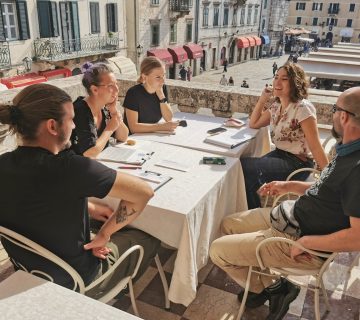Throughout 2018, events such as the European Heritage Days (EHD) gathered extraordinary momentum, as they connected communities from the national and the local level under the banner of the European Year of Cultural Heritage (EYCH). 10,000 events, 6,000 projects, four million participants and ten initiatives later, both heritage lovers and connoisseurs ask themselves, Now what? Where is heritage headed in the aftermath of the most widely celebrated year?
For starters, the EYCH acknowledged centuries of shared history and brought about a most necessary consensus that heritage is, in fact, a resource for the future. A single European identity might not actually exist, but values, political norms, and unity are far more important to pursue. Cementing the diversity of the European space under one static label is an ever more delicate undertaking when culture is more of a process than a caged bird. But how is Europe supposed to address such matters in the next decade? The short answer is, together. The long answer starts with a closer look at the current situation.
Complementarity
Because most heritage endeavours are delivered on a voluntary basis, funding is a major motor that needs our full attention. The key to such matters is complementarity, says Michel Magnier, Director for Culture & Creativity, Directorate General for Education and Culture, European Commission. Public and private funding need to find a way to complement each other. Also, we ought not to be scared of new technologies and ancient places excluding each other, just because we can’t yet grasp their intersections. Magnier says we need to implement documents such as the Faro Convention, revise enclosed ideas within the Venice Charter and introduce sustainable cultural tourism. Finally, heritage needs to create a labour market in order to thrive.
Baukultur (the concept of building a culture as well as physical building)
The merge of old and new is a constant battlefield for practitioners of traditions but mostly for architects or town planners, which affects everyone. Kathrin Merkle, Head of Culture and Cultural Heritage Division in the Council of Europe notes that heritage is celebrated in our world, but the line of the intangible embeds into culture, contemporary art will be the future heritage, natural parks juxtapose with culture or sometimes with art or landscapes and, historical heritage digitised will become a digital experience. But Christina Haas perceives that culture seems unimportant in the expansion of the faceless grey neighbourhoods across Europe. As a specialist of ‘Baukultur’ working for the Swiss Federal Office of Culture, Haas believes now is the critical time to place culture into new constructions. Heritage gives comfort to personal stories, but the everyday built environment creates meaningful places that need inclusion too. These are the three main mantras from the Davos Declaration that should precede any heritage professional’s future strategies. Culture is dynamic; it includes contemporary works and process.
Taking sides
Not long ago, heritage was a political target of values of diversity, human rights, and plurality. Taja Vovk van Gaal, Creative Director of the House of European History, recalls vividly the struggle of museums to become centres for debate and openness. Critics argue the fight is far from over, and as such museums should take a stance rather than avoid embracing a comfortable neutrality.
Connect people to their heritage
What we consider our heritage might seem different from another perspective. Striving to value our stories without excluding others requires us to aim for universal values. Interpret Europe asks the question, How can we help people connect to their heritage? Thorsten Ludwig, Managing Director, says interpreters exist to facilitate that process. To apply that to real life, the future of heritage splits into four dimensions: offering the past a deeper meaning through experience, participation and stewardship.
Educating on what’s human
Thinking about heritage as a safe place, away from mass tourism, over-exploitation, climate change, away from destruction, vandalism and illegal trafficking are all noble pursuits supported by international documents such as the European Convention on Offences relating to Cultural Property and Sustainability Agenda. Yet in order to have a more dynamic view of heritage, we need to educate new and elderly generations about what makes us human. Kathrin Merkle, the Head of Culture and Cultural Heritage Division at the Council of Europe, reminded us that for the future to be stripped of unnecessary categorisations, we need to focus our attention on similarities instead of differences.
Digital empowerment
Without a doubt, the internet has changed the world. It re-created heritage as a digital experience. And while the rise of digital applications power up heritage to new dimensions, not all such products deliver excellency. Dragana Lucija Ratković Aydemir, Director of Muze consultancy in Zagreb, subscribes to it being a matter of approach, not just financial restrictions. The digital world can be empowering but can also be excruciatingly competitive, and cutting corners won’t do. She proposes that creative and cultural industries should strive for interconnectedness, where authorship rights for skilled professionals are envisioned, an approach which in time will lead to higher standards for digital products.
Finally, the future of heritage should aim at including all stakeholders. Every heritage professional should strive to attain project management skills in order to empower local stakeholders to take over the journey of their heritage.
The future decade of heritage should look not necessarily bright or digital, but inclusive, dynamic, sustained, empowered, brave and human.
Eliza Marin is the IE Country Coordinator Romania and an emerging heritage professional. She lived in Germany for five years, recently returning to Romania to join the ProPark foundation. She can be contacted at: eliza.marin@interpret-europe.net.
To cite this article:
Marin, Eliza (2019) ‘Now what? Life after the European Year of Cultural Heritage’. In Interpret Europe Newsletter 1-2019, 4.
Available online:
www.interpret-europe.net/fileadmin/Documents/publications/Newsletters/ie-newsletter_2019-1_spring.pdf




